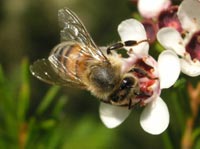
![]() Social insects like ants, bees and wasps are some of the most successful animals on the planet. By acting as large super-organisms, they can achieve things that larger singular creatures cannot.
Social insects like ants, bees and wasps are some of the most successful animals on the planet. By acting as large super-organisms, they can achieve things that larger singular creatures cannot.
 Their astounding selflessness is driven by an unusual way of handing down their genes, which means that females actually have more genes in common with their sisters than they do with their own daughters. And that makes them more likely to put the good of their colony sisters over their own reproductive legacy.
Their astounding selflessness is driven by an unusual way of handing down their genes, which means that females actually have more genes in common with their sisters than they do with their own daughters. And that makes them more likely to put the good of their colony sisters over their own reproductive legacy.
The more related the workers are to each other, the more willing they will be to co-operate. So you might expect colonies of social insects with fairly low genetic diversity to fare best. But that's not the case, and Heather Matilla from Cornell University has found that exactly the opposite is true for bees.
Bee queens will often mate with several males (a strategy called polyandry). It's an unexpected tactic, for it means that the queen's daughters will be more genetically diverse and slightly less related to each other than they would be if they all shared the same father. And that could mean that selfless co-operation becomes less likely.
Despite this potential pitfall, social insect queens do frequently sleep with many males, and all species of honey bee do this. There must be some benefit, and Mattila has found it. Together with Thomas Seeley, she showed that a genetically diverse colony is actually a more productive and a stronger one.
 For a honeybee, setting up a new colony is a difficult business. It starts when the fertile queen sets off with a swarm of several thousand infertile workers to establish a new nest. From the moment they do this, the clock is ticking.
For a honeybee, setting up a new colony is a difficult business. It starts when the fertile queen sets off with a swarm of several thousand infertile workers to establish a new nest. From the moment they do this, the clock is ticking.
Before the harsh conditions of winter sets in, they need to build a hive, collect food reserves and replace their ageing workforce with fresh workers, all from scratch. If they're inefficient, the colony will die of starvation in the winter cold and, indeed, 80% of colonies perish in this way.
To test the effect of genetic diversity on efficiency, Mattila and Seeley artificially inseminated 21 queens with the sperm of either a single male drone or fifteen different ones. The queens were relocated to a blank hive in early June, together with almost 8,000 of her daughter workers, and watched.
Two weeks later, the genetically diverse colonies were already out-competing and out-producing their genetically narrow counterparts. They expanded their hives (in terms of comb area) by 20% more, collected up to 78% more food and they built up 39% larger reserves of food. And all this was done with almost exactly the same number of workers - they just worked harder and faster.
The more efficient colonies made better use of a time of plenty, when collectable food was freely available. And by the end of August, they had reared so many more young that their workforce was five times larger than their dawdling rivals.
 Their success not only gave them a competitive advantage - it ensured their survival. In late August, a cold period killed about half of the single-father colonies and by December, they were all dead. But the multi-father ones all pulled through the autumn cold and 25% made it past the winter freeze.
Their success not only gave them a competitive advantage - it ensured their survival. In late August, a cold period killed about half of the single-father colonies and by December, they were all dead. But the multi-father ones all pulled through the autumn cold and 25% made it past the winter freeze.
With such better results, it's no surprise that the queens of so many social insect species mate with multiple males. There would be intense natural selection for this strategy, and it would spread extremely quickly through the bee populations.
But one important question remains: why are the genetically diverse colonies more efficient? Mattila and Seeley point to previous research, which shows that a worker's genes strongly affect the probability that they will take on certain tasks around the hive.
For example, workers start to ventilate the hive when it gets too hot and their genes set their internal thermostat, determining what each workers thinks is 'too hot'. A genetically narrow workforces risks not responding at all to changes in temperature or to over-respond, with the entire hive involved.
In contrast, a genetically diverse workforce would have a broad range of critical temperatures, and be able to respond more appropriately to subtle heating and cooling patterns in the hive.
During times of hardship, it's more likely that the hive will have plenty of workers with the genetic background to cope with it. And in times of plenty, a larger proportion of workers will be willing to take advantage of new resources.
Reference: Mattila & Seeley. 2007. Genetic diversity in honey bee colonies enhances productivity and fitness. Science 317: 362-364




As always, nicely done, holmes!
That's really interesting--I wondered why a more diverse hive was more efficient as I was reading. As the old saying goes, "it takes all kinds." Human diversity works too.
Do the queens really "sleep with" the males? Who gets up and makes the tea in the morning? ...